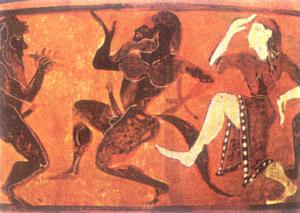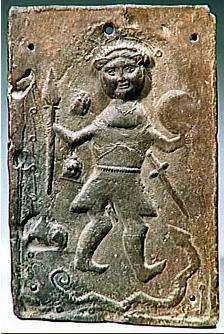No one really thinks about it, but our whole life is directly connected with the symbols that surround us. Some people treat them neutrally, while others arrange a cult of them, sometimes reaching fanaticism. A whole world of characters around us. They are in all spheres of life, from TV shows and movies to religious rites. We must not forget about the poetic form, where each composition is often in addition to the main meaning and subtext. And the double meaning is one of the main characteristics necessary to determine the true essence. It would seem that ordinary at first glance objects actually carry a completely different symbolism and subtext. German Hesse, for example, believed that every phenomenon on earth is a symbol, and through it the soul penetrates into our world.
Images with a phallic meaning were popular with most nationalities, on all continents of our planet, therefore, creators (painters, sculptors, writers) often used them in their works.
Phallic symbols - what is it?
These include images and objects that can cause associations with the fertilization organs, both male (phallus) and female (kteis). However, you should not limit such characters to extended and standing objects, as many authors studying this issue do. Since the reproductive function is one of the most important for humans, respectively, and many peoples, their cultures respect everything that is directly or indirectly associated with this process. In almost any religion in the world, you can find symbols that are similar or directly depicting the phallus or other genital organs. This feature did not bypass the righteous at first glance Christianity.
Prehistoric Phallic Symbols
The first information about the use of phallic symbols refers us to the Neolithic times, the postglacial period. The phalluses depicting masculine power and the basis of the genus were depicted in the drawings found in caves on the territory of modern France. According to the examination, these figures are about 30 thousand years old. In Sweden, images of the Bronze Age were found, on which a hunter with clearly hyperbolized genitals is clearly distinguishable.
In Zimbabwe, a drawing of a huge penis with a straight line stretching along and turning into a lily flower was discovered, which, according to historians, symbolized sexual intercourse and procreation. As these findings show, the phallic symbols of antiquity were used in art and life throughout the entire planet, despite the lack of contacts and connections between continents.
Symbols of the phallus in Ancient Greece, Ancient Egypt and Rome
The origin of modern civilization began in the Mediterranean region, at the source of the Nile, the most fertile part of Egypt. The cult of the phallus was quite popular in Egyptian ancient mythology and was represented by the deities Min, Amon Ra, and Asiris. There were legends about the size of the genitals of the pharaohs. Some phallic symbols can be found in the expositions of the local history museum in Cairo.

Many artifacts of the era of Ancient Greece have survived: phallus sculptures erected in honor of the god Dionysus, as well as images of celebrations in his honor. Also, sculptures of Priapus, the demon god, the main representative of phallic symbolism in this ancient culture, have survived to our days. Often Priapus's reproductive organ was portrayed longer than his body, thereby showing his power. In honor of him, sculptures were installed, representing a long stone deck with the head of a bearded man and a long penis. Later, the phallic traditions of the Hellenes migrated to Ancient Rome, where similar images and artifacts acquired the magical power of amulets. According to legend, they averted the evil eye and protected from evil otherworldly forces. Almost every yard had a similar totem.
Slavic culture
Phallic symbols among the Slavs can be found in almost every pagan deity. In addition, they were widely used in ceremonies. They were perceived by the Slavs as amulets. Sometimes a mascot in the form of a phallus was hung on the gate and, according to the owner, helped in the development of the household. Even the Russian word “luck” has the ancient Slavic root “ud”, which corresponds to the name of the ancient god responsible for the successful fulfillment of love contacts. God Oud was depicted in drawings with another erotic sign - a wreath of viburnum, a symbol of virginity and chastity. The wreath was pierced by the horns of Oud, which meant the first sexual contact. Souvenir phalluses in the territory of Ancient Rus were made from different materials. In particular honor was bronze.

Another tradition of the pagans was the baking of Easter cakes. The shape of such a product was reminiscent of a male genital organ with a characteristic hat on top, covered with white sugar glaze (similar to male seed). Kulich sprinkled with grain, which symbolized the fertility and awakening of nature. Often, such baked goods were supplemented with colored eggs, which in the complex is built into an explicit symbol of the male reproductive organ. It was Kulich after the baptism of Rus that passed from pagan to Christian tradition, in fact, retaining its original meaning.
The role of symbols in Christianity
Replacing paganism in Kievan Rus, Christianity, however, incorporated many phallic symbols of Slavic gods. At the same time, it also brought its own. Phallic symbols in Christianity can be found at every turn. For example, the dome that crowns the Orthodox and Catholic churches is nothing but a symbol of the uncircumcised phallus (as among the Jews). It is worth looking at the classical structure of Christian churches, where the base is like a scrotum, and the high part resembles a phallus. It should be noted that at the dawn of the birth of Christianity, Jesus was portrayed with genitals. A good example is the Terracotta from the time of the Merovingians from the Saint Germain Museum, depicting Jesus with a penis. At the same time, he holds a spear in one hand and the moon in the other and defeats the evil represented in the form of a snake. Another main symbol that every Christian should have is the cross. According to legend, it was also a sign of the genital organ. In addition to hidden symbols, open phallus images were used in Christianity, for example, in the decoration of some Catholic churches in Spain, the Czech Republic, and France. Also, with the development of pilgrimage to holy places, phallic symbols appeared in commemorative badges offered by monks.

Falling popularity of phallic symbols
With the advent of the era of the Reformation, this cult has lost its popularity. Phallic symbols in art are less common. Sexuality was taboo, and all the references to the phallus in works of art were tried to paint over, and the genitals on the sculptures were covered with fig leaves. Many scholars of those times condemned sexuality and were ashamed of references to its attributes in culture. This ban lasted about 200 years, and during this time many works of art were redone, but not all of them could then be restored to their original form.
Freud and the rebirth of a culture of sexuality
One of those people who lifted bans on the topic of sexuality was the famous German psychologist Sigmund Freud. He believed that human thoughts are transformed into images and symbols. Phallic symbols, according to Freud, take place in almost any subject. They, along with other unconscious images, often appear in sexual forms. Many consider Freud’s theory to be erroneous and untenable, but the resonance that it left in society clearly influenced contemporary art and society as a whole, rediscovering sexuality to the world and eliminating the taboo imposed on phallic symbols.
Modernity
Nowadays, phallic symbols are not something shameful and are used everywhere. They can be found in modern painting, sculpture, literature. Many artists try to shock the public by using genital images in their installations. There was such a form of phallic art as a naked performance, where the person acts as the main canvas for art, and direct demonstration of the genitals is nothing but the expression of one’s emotions through the symbols of body parts. Also, phallus images and their symbols are sold as various souvenirs in many countries, especially the Asian region.